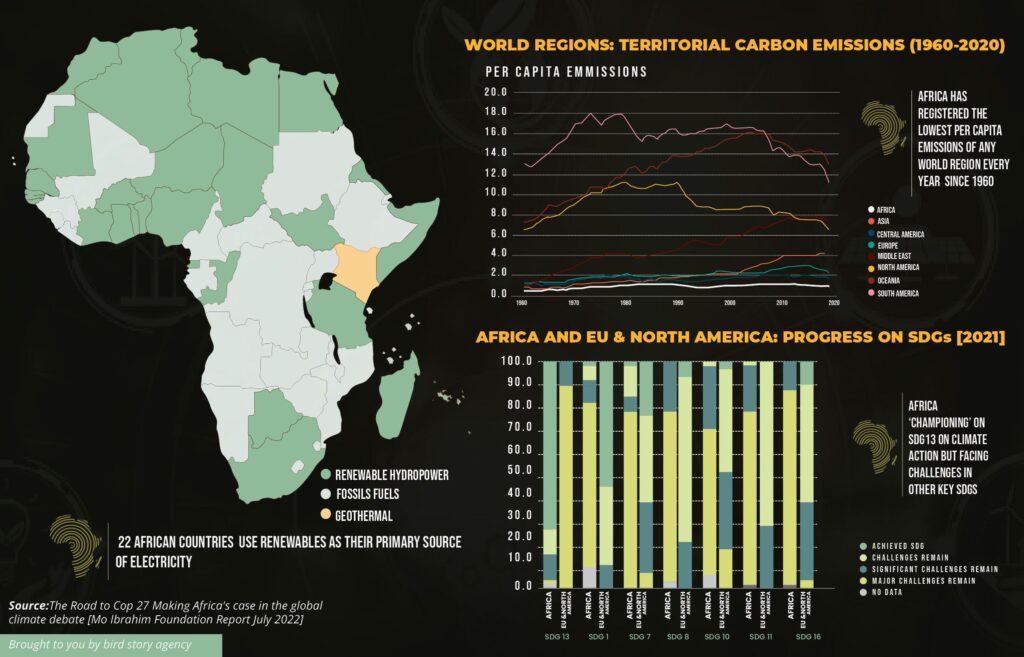By comparison with the rest of the world, African states tread lightly, responsible for just 3.3% of global carbon emissions – eight times less than Asia, Europe and North America. Each. In the words of the Mo Ibrahim Foundation, it is the least responsible but pays the highest price.
Who takes the best carbon action report card to Cop-27? Africa does.

Seth Onyango, bird story agency
By comparison with the rest of the world, African states tread lightly, responsible for just 3.3% of global carbon emissions – eight times less than Asia, Europe and North America. Each. In the words of the Mo Ibrahim Foundation, it is the least responsible but pays the highest price.
And while drought and floods and their attendant griefs will (and should) make a story at Cop-27, there’s one report card where the continent shines.
The Mo Ibrahim Foundation’s 2022 Forum Report, called The Road to Cop-27, shows that three in four countries have met their requirements to submit their Nationally Determined Contributions plan to cut emissions – even if these are low.
There is still a challenge to align these with national development plans, the report has found, but the continent has displayed more political will to cut emissions than many countries in other regions.
There is also a much higher accession rate to the United Nations Sustainable Development Goal 13 – which deals with a reduction in greenhouse gas emissions (GHGs) – in Africa compared to North America or the EU.
The Mo Ibrahim Foundation reports that in Namibia, almost one-fifth of electricity (19.1 per cent) is generated through solar, the fourth highest share globally.
The Forum Report shows that clean energy provision is improving. But there are still 600 million people on our continent without a reliable and efficient source of energy, so the road is long.
Still, the Foundation spotlights a steady rise in public investment in renewable forms of energy by African states, where between 2010 and 2019, it tripled from US$ 13.4 billion to US$ 47.0 billion.
The report finds that 22 African countries use renewables as their main electricity source, with eight generating over 90 per cent of their power from renewable sources.
These are: Central African Republic (96.3 per cent), DR Congo (98.9 per cent), Eswatini (99.8 per cent), Ethiopia (100.0 per cent), Lesotho (99.9 per cent), Mozambique (95.4 per cent), Namibia (91.0 per cent) and Uganda (97.7 per cent).
According to the International Energy Association’s Africa Energy Outlook 2022 report, clean energy will account for a significant part of generating capacity additions by 2030.
“Solar PV leads the way, with 125 GW of capacity to be added between 2021 and 2030, over 40 per cent of total capacity additions,” the Energy Outlook report states.
Currently, Africa’s abundant sunshine provides only one per cent of the world’s installed solar photovoltaic (PV) capacity, despite being home to 60 per cent of the best solar resources globally.
“Of the top 20 per cent of solar sites globally, Africa is home to around 60 per cent of them by land area… the projected average rate of solar PV capacity additions is roughly equal to that of India in recent years,” the global energy association finds in its Sustainable Africa Scenario.
“Renewables, including solar, wind, hydropower and geothermal account for over 80 per cent of new power generation capacity to 2030 in the Sustainable Africa Scenario.” This scenario sketches an optimal energy solution.
Solar PV, already the cheapest source of power in many parts of the continent, should win out over other energy sources continent‐wide by 2030, says the IEA. There are blobs of optimism everywhere.
The Mo Ibrahim Foundation reports that in Namibia, almost one-fifth of electricity (19.1 per cent) is generated through solar, the fourth highest share globally.
In Kenya, geothermal energy accounts for almost half (46.0 per cent) of electricity generation, more than any other country in the world.

Meanwhile, 21 of the 52 countries using hydropower as the primary source of electricity are African.
But in the 22 African countries that use renewables as their primary source of electricity, access to electricity remains limited, with only Gabon having over 90 percent access to electricity.
In 16 of the 22 countries, more than half the population still lack electricity, highlighting both an energy landscape of deep need but also one of enormous potential.
In June 2020, finance giant, Goldman Sachs projected in a report entitled “Carbonomics” that spending for renewable power projects in 2021 will surpass upstream oil and gas for the first time in history.
The Mo Ibrahim Foundation report shows South Africa, Ethiopia, Egypt, Morocco and Kenya are building clean energy economies that will attract billions of dollars in investment over the next decade. Investments by domestic and global businesses are being made in renewable and low-carbon infrastructure. Rwanda wants to generate 60 percent of its energy needs from renewables come 2030.
Six African countries – Egypt, Kenya, Mauritania, Morocco, Namibia, and South Africa – launched the African Green Hydrogen Alliance in May 2022, to promote the production of hydrogen using clean energy.
The gas is a potential replacement for natural gas and European countries are investing heavily in future production in parts of Africa where clean energy sources are also abundant.
The alliance plans to foster collaboration between its founding members to advance green hydrogen development in their respective countries.
The challenge of distribution networks, however, remains. For every US$10 invested in the African energy sector since 2015, just over US$1 went on transmission and distribution.
More than a decade ago, at COP15, developed nations decided to commit to a goal of jointly mobilizing US$100 billion a year by 2020 to address the needs of developing countries. In 2020, just over US$80 billion was raised.
At the United Nations earlier in 2022, US President Joe Biden announced America would increase its international climate finance contribution to US$ 11.4 billion per year by 2024 to help developing nations fend off the worst impacts of global warming.
This, together with Europe’s need to build an alternative energy source, may see investments into clean energy surge on the “clean” continent.
bird story agency




